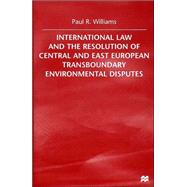
What is included with this book?
| Acknowledgements | xi | ||||
|
xiv | ||||
|
xvii | ||||
|
xxi | ||||
| Introduction | 1 | (8) | |||
| Part I Central and East European Transboundary Environmental Disputes from the Baltic Sea to the Black Sea | 9 | (40) | |||
|
11 | (20) | |||
|
12 | (4) | |||
|
16 | (6) | |||
|
22 | (3) | |||
|
25 | (6) | |||
|
31 | (18) | |||
|
31 | (4) | |||
|
35 | (3) | |||
|
38 | (4) | |||
|
42 | (7) | |||
|
45 | (4) | |||
| Part II Using International Law to Resolve the Slovak-Hungarian Dispute concerning the Construction and Operation of the Gabcikovo-Nagymaros Project | 49 | (72) | |||
|
51 | (9) | |||
|
52 | (3) | |||
|
55 | (3) | |||
|
58 | (2) | |||
|
60 | (7) | |||
|
60 | (2) | |||
|
62 | (2) | |||
|
64 | (1) | |||
|
65 | (2) | |||
|
67 | (42) | |||
|
68 | (2) | |||
|
70 | (3) | |||
|
73 | (4) | |||
|
77 | (32) | |||
|
109 | (12) | |||
|
109 | (3) | |||
|
112 | (1) | |||
|
113 | (3) | |||
|
116 | (5) | |||
|
118 | (3) | |||
| Part III Understanding the Role of International Law | 121 | (44) | |||
|
123 | (12) | |||
|
123 | (4) | |||
|
127 | (8) | |||
|
135 | (30) | |||
|
135 | (4) | |||
|
139 | (6) | |||
|
145 | (9) | |||
|
154 | (11) | |||
|
162 | (3) | |||
| Part IV Prospects for an Increasing Role for International Law in Promoting Central and East European Transboundary Environmental Dispute Resolution | 165 | (53) | |||
|
167 | (21) | |||
|
167 | (3) | |||
|
170 | (5) | |||
|
175 | (4) | |||
|
179 | (3) | |||
|
182 | (6) | |||
|
188 | (30) | |||
|
188 | (3) | |||
|
191 | (6) | |||
|
197 | (2) | |||
|
199 | (5) | |||
|
204 | (3) | |||
|
207 | (11) | |||
|
215 | (3) | |||
| Conclusion | 218 | (10) | |||
| Notes | 228 | (52) | |||
| Bibliography | 280 | (45) | |||
| Index | 325 |
The New copy of this book will include any supplemental materials advertised. Please check the title of the book to determine if it should include any access cards, study guides, lab manuals, CDs, etc.
The Used, Rental and eBook copies of this book are not guaranteed to include any supplemental materials. Typically, only the book itself is included. This is true even if the title states it includes any access cards, study guides, lab manuals, CDs, etc.